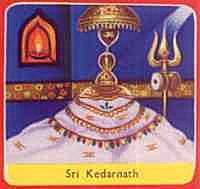Jyotirlinga
Sthalams
Kedarnath

Kedarnath is
situated in the Himalayan slopes in the Gharwal district of Uttar Pradesh.
The uniqueness and greatness of this temple sees mention in the vedas,
ithihaasaas, epics.
The term Kedara
for the Lord denotes
* The
Lord who holds the holy Ganges in his matted locks & allows it to flow
evenly to the world.
* It
could also mean the mark that is left on the Lord's head from the time
when Arjuna got the Paasupathastram.
This shrine
is located at an elevation of 11,735 feet above sea level. The region
of the Himlayas, where the shrine is located is known by several names
such as Gandhamadana parvatham, Sumera parvatham, Pancha parvatham, etc.
(Pancha parvatham, for this is the spot of five sacred peaks namely Rudra
Himalayas, Vishnupuri, Brahmapuri, Udayagiri & Swargarohini.
The exterior of
the temple is rather simple, but the interior is adorned with marvellous
sculptures. In the garba griha is an irregular shaped conical rock
which is about five feet by four feet. Lord Siva in the form of jyotirlingam
is worshipped here as Lord Kedareshwar. It is believed that the jotirlingam
is actually the rump of the bull, which was the form that Lord Siva assumed,
when the Pandavas tried to reach him to atone the sins of the Kurukshetra
war. Since it was not time designated for humans to worship the Lord
here, Lord Siva tried to go away in the form of a bull. It is believed
that temple structure that exists till date was actually the one constructed
by the Pandavas.
The sannadhi
of the Lord is facing South. There are the idols of Kedaragowri,
Krishna, Pandavas, Draupadi, Vinayagar, Veerabadrar, Kaarthikeyan, Nandi..
The shrine is covered by snow for 6 months in a year (closed from Oct-Nov
upto Apr-May). It is believed that this is the time when the Devas
are worshipping the Lord.
There is mountain
path called Sorga Vaasal, through which the Pandavas, Sankaracharyar are
supposed to have gone through. he river Mandakini flows down from
near this area.